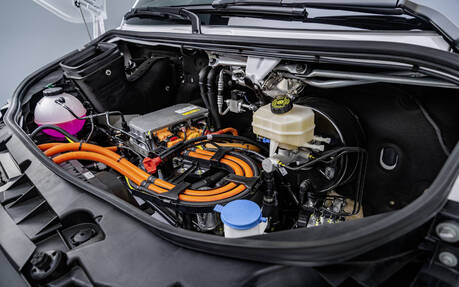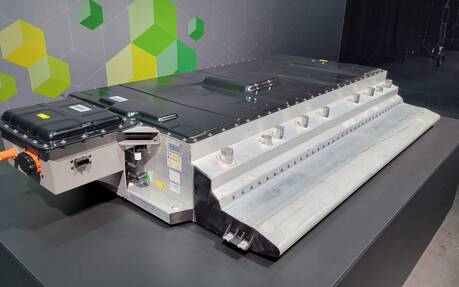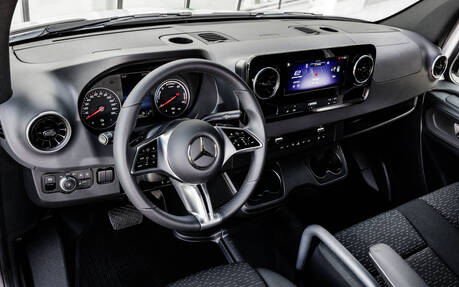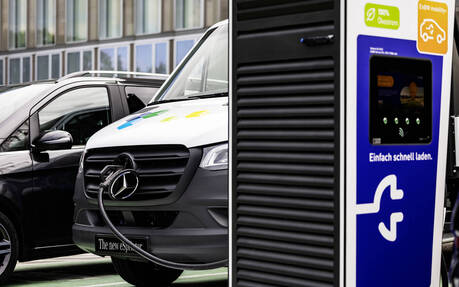The 2024 Mercedes-Benz eSprinter is an Electrified Workhorse
The commercial van segment rarely gets flashy auto show unveilings reserved for popular models, nor does it include all the technology that the brand relies on to stand out in other, more consumer-oriented segments. In general, it kind of goes unnoticed in the automotive world. Over the last few years, however, the niche has gained momentum - waiting lists for commercial vans like the Mercedes-Benz Sprinter are getting longer, sometimes stretching for months, and even years.
The commercial sector is always hungry for urban transport vehicles, of course. But this renewed demand is also fuelled by the common folk’s thirst for adventure. Converting vans into recreational vehicles has gained popularity during and after the pandemic with the “van life” trend, attracting a new class of buyers.
- Also: 2023 Mercedes-Benz Sprinter: Vanlife, Elevated
- Also: Converting Your Vehicle Into a Camper: What You Need to Know
Even if they seem slower to convert to electric, the commercial van and RV niches will have to get with the program. And while Mercedes-Benz plans to build an electric-only platform for its commercial vehicle fleet in 2025, it certainly doesn't want to miss out on the action until then. Especially since its big rival, the Ford Transit, already has an electric variant.
Hence, the automaker has electrified its Sprinter van by adding a large battery and electric motor to the existing chassis. And now, it's coming to North America.

Same Platform, But Electrified
The eSprinter is powered by a single electric motor connected to a battery, which means it’s available in rear-wheel drive configuration exclusively. The variant that will be offered at launch for the Canadian market is the 3500 extended wheelbase (170 inches), so the battery that concerns us is the largest available with the eSprinter, with a usable power of 113 kWh. All this allows the van to put 204 horsepower and 295 lb-ft of torque at its driver's disposal. Max payload ranks in at 2,624 lb.
As for the range, it promises an estimated 304 kilometres according to unofficial North American EPA standards. However, the official Euro standard WLTP cycle ranked the eSprinter at 400 kilometres, and Mercedes-Benz claims to have obtained more than 400 kilometres during testing conducted on highways between Stuttgart and Berlin in Germany. Of course, this unscientific study wasn't conducted with the pedal to the metal on a limitless Autobahn, but at speeds that rarely exceeded 90 km/h and in mild summer weather.

The eSprinter's battery is the LFP (nickel-free, cobalt-free) type that is known for its durability, and weighs 1873 pounds on its own. A maximum charging power of 50 kW is possible as standard, which is relatively low. However, this can be increased to 115 kW with optional equipment, which can take the eSprinter's battery from 10 to 80% in 42 minutes, according to the manufacturer.
Other markets will receive various variants of the eSprinter, but all offer less power and less range. Although Mercedes-Benz plans to introduce more variants in North America based on demand, it will probably take until the next generation in 2025 to get an all-wheel-drive model...
An MBUX that Focusses on Electrified Commercial Driving
The new eSprinter gets the latest iteration of the Mercedes-Benz User Experience (MBUX) system, which the automaker says is faster and smarter than the previous version. It contains features that are specific to the electric powertrain, such as a navigation system that can recalculate the vehicle's range based on a proposed route, taking the topographical data into account. This MBUX infotainment system is displayed on a 10.25-inch screen in the centre of the dashboard.
It also offers a range of features to make fleet managers' jobs easier. Like the ability to program up to 7 separate driver profiles that can have their own geofencing settings and individual driver logs.

What Mercedes-Benz calls the "range potato" is also an interesting feature in itself. It informs the driver how far he or she should drive in order to return to the starting point on a single charge. This takes into account the distance to be covered, but also the truck's load and the changes in elevation on the route. A radius around the truck is calculated on the map and displayed on the infotainment system screen (and this radius is usually in the shape of a potato...)
At an estimated 304 kilometres, the eSprinter doesn't offer much range on paper, but it's more than enough for businesses that need to make local deliveries efficiently and without stopping at the gas pump. And if those businesses are equipped with charging points that feed their vans overnight, the eSprinter becomes a very interesting proposition.

On the other hand, van life enthusiasts will have to plan their trips carefully, and be patient with charging. The 2024 Mercedes-Benz eSprinter will land in Canada at the end of October. Pricing starts at $97,990 and the federal government's iMHZEV EV program offers a purchase incentive of up to $10,000.
